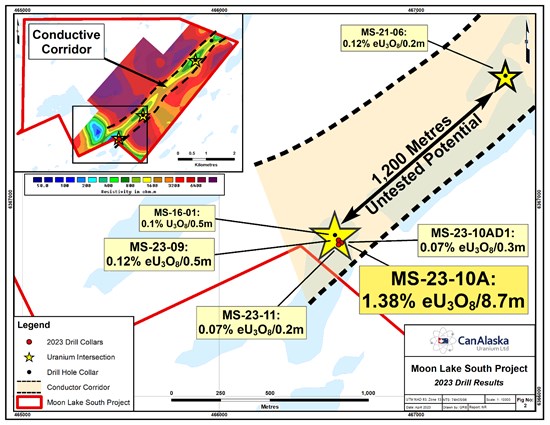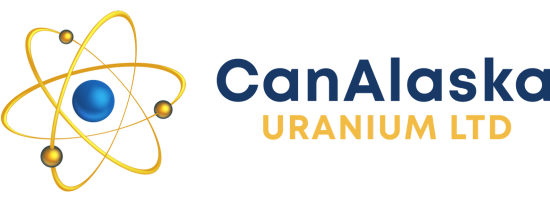Drillhole MS-23-10A Drills 8.7 Metres @ 1.38% eU3O8
Mineralization Open Minimum 1.2 Kilometres Along Uranium-Rich Target Corridor
Vancouver, British Columbia–(Newsfile Corp. – April 19, 2023) – CanAlaska Uranium Ltd. (TSXV: CVV) (OTCQX: CVVUF) (FSE: DH7N) (“CanAlaska or the “Company”) is pleased to report that drill hole MS-23-10A has intersected 1.38% eU3O8 over 8.7 metres, including 2.88% eU3O8 over 3.1 metres, as part of the recently completed winter exploration program at the Moon Lake South property. Uranium mineralization was encountered in four of the six drill holes completed during the winter. The objective of the 2023 winter drill program was to further evaluate the uranium mineralization identified in 2021. Results of the winter exploration program, combined with previous drill programs, has now confirmed uranium mineralization in multiple zones over a strike length of 4-kilometres along the CR-3 target corridor. The Moon Lake South JV Project is operated by Denison Mines Corp. (“Denison”) and CanAlaska holds a 25% ownership in the project (Figure 1). CanAlaska is funding the Company’s share of the 2023 exploration program.

Figure 1 – Moon Lake South JV Project Location
2023 Moon Lake South Winter Exploration Program Highlights
Drill hole MS-23-10A was completed approximately 50 metres southeast of MS-16-01 and intersected several zones of uranium mineralization (Table 1). The most significant intersection in MS-23-10A consists of a broad zone of unconformity-associated uranium mineralization grading 1.38% eU3O8 over 8.7 metres, including 2.88% eU3O8 over 3.1 metres, approximately 30 metres above the unconformity. The mineralization in MS-23-10A represents the best mineralized intersection drilled to date along the CR-3 conductor on the Moon Lake South project. Given the limited number of drill holes completed during the winter program, the mineralization discovered in MS-23-10A remains open in multiple directions for future follow-up.

Figure 2 – Target Corridor of 2023 Moon Lake South Drill Program
Overall, the 2023 winter exploration program consisted of six completed diamond drill holes totalling 3,301 metres, of which four drill holes contained uranium mineralization, one of which had high-grade. Each of the holes completed during the winter program intersected indicative alteration and structural disruption in the lower sandstone column related to faulting along the CR-3 target corridor. At the conclusion of the winter drill program, the mineralization intersected on the southern portion of the CR-3 corridor remains open along strike for at least 1.2 kilometres to the northeast. The mineralized intersections from the 2023 winter exploration drilling program are illustrated in Figure 2 and summarized in Table 1 below.
Table 1 – 2023 Moon Lake South Winter Exploration Drilling Results
| DDH | From (m) | To (m) | Length (m)6 | Average Grade (% eU3O8)7 |
| MS-23-091,2 | 408.45 | 408.65 | 0.2 | 0.06 |
| MS-23-091,2 | 451.45 | 451.95 | 0.5 | 0.12 |
| MS-23-10A2,3 | 417.75 | 426.45 | 8.7 | 1.38 |
| Including 4 | 421.45 | 424.55 | 3.1 | 2.88 |
| MS-23-10A2,3 | 430.85 | 432.05 | 1.2 | 0.07 |
| MS-23-10AD12,3 | 441.05 | 441.35 | 0.3 | 0.07 |
| MS-23-112,5 | 450.75 | 450.95 | 0.2 | 0.07 |
| MS-23-09 was drilled at an azimuth of 311˚ with an inclination of -80˚, collared at 466605.8 mE / 6366792.8 mN, 518.7 m A.S.L. (UTM NAD83 Z13N).Intersection interval is composited above a cut-off grade of 0.05% eU3O8 with a maximum of 1.0 m of internal dilution.MS-23-10A and MS-23-10AD1 were drilled at an azimuth of 311˚ with an inclination of -81.5˚, collared at 466620.0 mE / 6366779.4 mN, 518.5 m A.S.L. (UTM NAD83 Z13N).Intersection interval is composited above a cut-off grade of 2.0% eU3O8 with a maximum of 1.0 m of internal dilution.MS-23-11 was drilled at an azimuth of 309˚ with an inclination of -81.5˚, collared at 466606.4 mE / 6366770.1 mN, 518.6 m A.S.L. (UTM NAD83 Z13N).All reported depths and intervals are drill hole depths and intervals, unless otherwise noted, and do not represent true thicknesses, which have yet to be determined.Radiometric equivalent (“eU3O8“) derived from a calibrated gamma downhole probe. | ||||
CanAlaska CEO, Cory Belyk, comments, “The third drilling program on the Moon Lake South JV project has intersected a new and wide zone of high-grade uranium mineralization in the heart of the eastern Athabasca Basin, near critical mine and mill infrastructure. This is an incredible result for the Moon Lake South Joint Venture and CanAlaska shareholders. Early drill results of this magnitude are very rarely encountered and speak to the technical expertise of the teams guiding the joint venture. CanAlaska looks forward to participating with Denison in the advancement of this new discovery of high-grade uranium mineralization.
“CanAlaska now has multiple uranium discoveries on multiple exploration projects in what is a strengthening uranium market. The time for critical mineral discovery is now and CanAlaska’s Athabasca Basin uranium portfolio is delivering new discoveries.”
Radiometric Equivalent Grades, Sampling, Analysis and Data Verification
Denison is the operator of the Moon South Joint Venture and uses radiometric equivalent-grades to report exploration results prior to the receipt of chemical assays. For results from the Moon Lake Joint Venture, Denison has performed QAQC and data verification, where possible, of all datasets. According to Denison’s procedure, following the completion of a drill hole, the hole is radiometrically logged using a downhole gamma probe, which collects continuous readings of radioactivity along the length of the drill hole. Probe results are then calibrated using an algorithm calculated from the comparison of probe results against geochemical analyses in the area. The gamma-log results provide an immediate radiometric equivalent uranium value (eU3O8%) for the hole, which, except in very high-grade zones, is reasonably accurate. Typically, eU3O8 is reported as a preliminary result and subsequent definitive assay grades are reported following sampling and chemical analysis of the mineralized drill core. CanAlaska has performed QAQC and data verification prior to disclosure.
According to Denison’s procedure, assay sample intervals are generally 50 centimetres long, except where higher or lower-grade mineralization boundaries fall within the interval. In that case, two 25 centimetre samples are collected. Flank samples of 1.0 metre are always collected where mineralization is located. Systematic geochemistry samples are collected every 10 metres down the hole.
According to Denison’s procedure, all assayed core is split in half, with one half retained and the other sent to the Saskatchewan Research Council Geoanalytical Laboratory in Saskatoon for analysis. Control samples are routinely assayed with each batch of core samples analyzed.
About CanAlaska Uranium CanAlaska Uranium Ltd. (TSX-V: CVV; OTCQX: CVVUF; Frankfurt: DH7N) holds interests in approximately 350,000 hectares (865,000 acres), in Canada’s Athabasca Basin – the “Saudi Arabia of Uranium.” CanAlaska’s strategic holdings have attracted major international mining companies. CanAlaska is currently working with Cameco and Denison at two of the Company’s properties in the Eastern Athabasca Basin. CanAlaska is a project generator positioned for discovery success in the world’s richest uranium district. The Company also holds properties prospective for nickel, copper, gold and diamonds.
For further information visit www.canalaska.com.
On behalf of the Board of Directors
“Cory Belyk”
Cory Belyk, P.Geo., FGC
CEO, Executive Vice-President and Director
CanAlaska Uranium Ltd.
Contacts:
| Cory Belyk, CEO and President | General Enquiry |
| Tel: +1.604.688.3211 x 138 | Tel: +1.604.688.3211 |
| Email: cbelyk@canalaska.com | Email: info@canalaska.com |
Neither TSX Venture Exchange nor its Regulation Services Provider (as that term is defined in the policies of the TSX Venture Exchange) accepts responsibility for the adequacy or accuracy of this release.
Forward-looking information
All statements included in this press release that address activities, events or developments that the Company expects, believes or anticipates will or may occur in the future are forward-looking statements. These forward-looking statements involve numerous assumptions made by the Company based on its experience, perception of historical trends, current conditions, expected future developments and other factors it believes are appropriate in the circumstances. In addition, these statements involve substantial known and unknown risks and uncertainties that contribute to the possibility that the predictions, forecasts, projections and other forward-looking statements will prove inaccurate, certain of which are beyond the Company’s control. Readers should not place undue reliance on forward-looking statements. Except as required by law, the Company does not intend to revise or update these forward-looking statements after the date hereof or revise them to reflect the occurrence of future unanticipated events.

